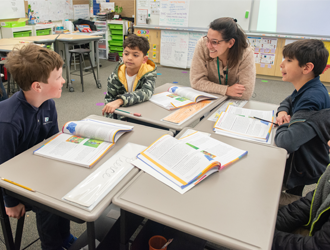Navigating Daily Routines with Fly Five

When it comes to setting students up to be successful, social and emotional learning matters. As educators integrate SEL curriculum and instruction within the classroom schedule, they are equipping students with the skills they need to stay focused and motivated throughout their learning. By recognizing opportunities for social and emotional learning activities that already exist in the classroom schedule, educators can make Fly Five’s SEL lessons a part of their daily routine—and create a successful academic environment for their students.
In order to strengthen academic achievement in schools and prepare students for lifelong success, SEL skills should be taught and practiced throughout the day. With busy academic schedules, it can seem difficult to find time to help students build these important skills on top of the core curriculum. Fly Five’s flexible curriculum, however, is readily able to be integrated throughout the school day so students have opportunities to gain social, emotional, and academic competence that will benefit them now and for the rest of their lives.

Fly Five Sets the Foundation for Academic Success

Each of the C.A.R.E.S. competencies contribute to a classroom environment where students are given the tools and opportunities to succeed socially and academically. Research confirms that when SEL is integrated into student learning, positive outcomes such as improved test scores and grades, increased graduation rates, strengthened feelings of safety, and improved well-being are all potential outcomes (Durlak et al., 2011; Taylor et al., 2017).

Embedding Fly Five throughout the Day
As you consider new ways to integrate SEL into your classroom, start by looking for opportunities that already exist in your current schedule and daily routines, such as adding in a mindful moment after recess to help students reset or giving students the language they need to work through a conflict. Fly Five offers specific components that make implementing social and emotional learning into the classroom convenient and easy—all while enhancing student learning! Consider the following components of Fly Five and how you can use them to integrate SEL into your daily classroom routine:
1. Mindful Student: Every day, your classroom is full of transitions—whether it be from one subject to another, returning from lunch or recess, or just starting and ending the day. With so much movement and change happening throughout their busy schedules, it’s no surprise that sometimes students can get a little off-track. Fly Five’s Mindful Student curriculum was designed to give students the tools they need to reset, refocus, and remain on a successful path. Look for times in your schedule where students could use additional support transitioning from one activity to the next and add in a quick mindfulness activity to help them adjust. The Mindful Student can also be used any time students could use extra support.
2. Character connections: The Center City Kids are at the core of the Fly Five curriculum, and help to make this learning engaging and relatable to students. Since the characters are designed to represent real-world student experiences, backgrounds, and identities, you can tie the characters into any aspect of learning throughout the day to spark student interest and help them to make connections between themselves and what they are learning.

3. Vocabulary: The Fly Five curriculum has a unique, developmentally appropriate SEL vocabulary that can make its way into your instruction across all subject areas to help students articulate and express their thoughts and emotions. As you and your students become familiar with SEL terms, it will give your classroom community a common language to share and connect through. Whether you are using the vocabulary to help students persevere through a difficult math lesson or your students are trying to express challenging emotions during a conflict on the playground, the vocabulary can show up in all aspects of learning and development.
“Whether it’s using vocabulary in the Morning Message, or encouraging students to be more open-minded when learning a new concept in math, the possibilities are endless!”
– Jill Brackett, Fly Five educator
Just like any new habit, integrating SEL into your daily classroom routine will take intentionality and thoughtfulness at the beginning. But soon, it will become second nature as you discover how Fly Five can help you make a positive difference in your class’ schedule by smoothing out transitions, keeping students focused, fostering learning engagement, and increasing student autonomy.
Activity:
With pen and paper, take a moment to write down ways you could integrate SEL into your classroom’s daily routine. Try out each one and see what works for your classroom and take notes reflecting on what you notice. Get inspired by some of the examples below:
1. At the beginning of each day, start off by having your students look at the Emotions Poster and identifying which emotion they are feeling.
2. After lunch when students are settling back into the classroom, have students engage in a quick mindfulness activity—and remember to take a mindful moment for yourself, too!
Mindful Student Samples:
Kindergarten First Grade Second Grade Third Grade
Fourth Grade Fifth Grade Sixth Grade Seventh Grade Eighth Grade
3. Share a read-aloud with your students that highlights a skill they will be utilizing during an upcoming
lesson, activity, or project and help them to understand how that skill will play a role in their learning.
References:
Durlak, J. A., Weissberg, R. P., Dymnicki, A. B., Taylor, R. D., & Schellinger, K. B. (2011). The impact of enhancing students’ social and emotional learning: A meta-analysis of school-based universal interventions. Child Development, 82(1), 405–432. https://doi.org/10.1111/j.1467-8624.2010.01564.x








